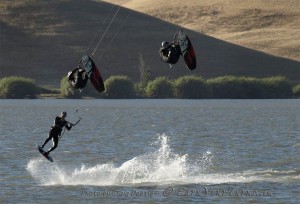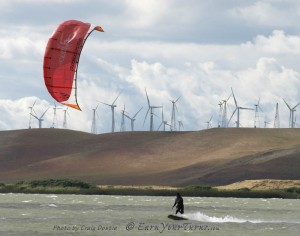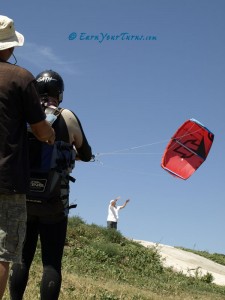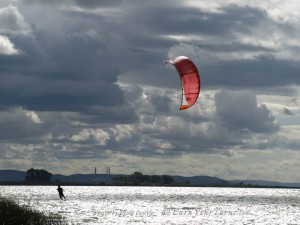If windsurfing is like sailing, then kiteboarding is like flying. Who can say they’ve never shared the dreams of Iccarus? To be sure, it isn’t really flying, but after finally taking lessons from Bruce Sheldon I found out in short order, the similarity is more true than not.
As a die-hard skier, windsurfing became my sport of choice when the snow melted and the warmth of the beach beckoned. It shares the adrenaline of speed with skiing, requires skill and balance, and harnesses natural elements. Unlike sailing a boat though, windsurfing is primal sailing, where your body is an integral part of the process, fulfilling the roles of shrouds and stays to hold the mast upright, your arms become human sheets to control the sail, and your legs steer the rudder. When the wind is up, it’s like being on trapeze all day while flying hull on a catamaran. It’s kind of like fun, only on steroids.
Over time reality has tempered my love affair with windsurfing, most notably by the lack of reliable wind. Unlike snow, which lingers after a storm and is thus relatively reliable, wind only occurs and lasts while conditions exist. One of the keys to sailing is to know where the wind is, or will be.
There are few better places for reliable wind than Sherman Island, where the Sacramento River joins with San Francisco Bay at the western end of the California Delta. Wind turbines abound in the Delta, an industrial testimonial to the wind’s reliability here.
The Delta is not known for its visual beauty, not that it doesn’t have any, but you need to look past the first impressions created by the levees that define this area. The Sacramento River is murky and wide at his point while garbage and algae define the tide line on the levee rocks like soap scum rings in a tub. No, the appeal is not so much visual as experiential.
When the tide ebbs the wind carves waves on the surface of the water and so it has become a mecca for windsurfers and kiteboarders. In between sessions on the water, Delta time governs the clock so that nothing matters much except relaxing and getting ready for the next session. The real appeal of the Delta is the contrast of balancing endorphin charged rides on the water with the healing aspects of abject laziness.
As I was saying, despite the relative reliability of the wind at the Delta, more often than not it was less than enough. In the past decade I’ve driven several times from Tahoe to the Delta amped to sail only to spend my time envying the kiteboarders ripping back and forth on the water. Relaxing on Delta time, away from the frustrations of the work clock, is only soothing after an energy burning session on the water. Besides them being on the water and I wasn’t, they were also enjoying another aspect of windsurfing I indulged in all too rarely — air time.
Catching air is always a thrill, as long as you don’t spill the landing. Because air is such an undeniable part of kiteboarding, it was clear I needed to take lessons from a pro rather than trust friends. Not that my friends don’t have the knowledge or patience to teach me the right way, but I’d owe ‘em way too many favors for taking that much time off from kiting themselves and they probably wouldn’t be brutally honest enough about my kite skills. That’s one thing you can count on from Bruce Sheldon Spradley, an honest assessment.
Instructor Bruce
Bruce came highly recommended by all my friends who had made the switch to kites, and as I would learn, with good reason. Bruce has been on the scene a long time. In the ‘90s, he patented a sail and boom rig that held the sail stiffer, more like a wing, and then using it managed to post a new American speed record on a windsurfer at 51.2 mph.
That all changed in 1998, though, when a friend from Hawaii insisted he learn how to kiteboard. Within a year his sails were collecting dust. He’s been teaching kiteboarding ever since, longer than anyone else in California.
Setting up the lessons with Bruce immediately became an exercise in humility. I was hoping to impress him with my experience as a sailor and skier to prove I was destined to be a quick study. Until I managed to get up on the board though, Bruce was relentless in his constant litany of warnings about the dangers of kiteboarding.

In a word, it boils down to air. I was well aware of the lethal potential that getting launched at the wrong time posed, having heard the gruesome details of a man who died after a gust picked him up and then slammed him into the front grill of a nearby car at Washoe Lake south of Reno. Throughout my training Bruce made sure I was aware of the many other options, like being skewered in a tree, bludgeoned by levee boulders, shredded by barbed wire, electrocuted by power lines, or getting so tangled in your kite lines you drown or were drug through a gauntlet of objects on land.
Naturally, I was hoping my experience with sailing and a brief two-hour session six years ago learning to kite ski would translate to a fast learning curve. However, Bruce’s relentless reminder that “it makes no difference to me whether you spend your time flying a kite, or swimming,” put the big kibosh on those aspirations really quick. It was clear, the majority spent a lot of swimming. Pausing for a moment, he would continue, “… the better you know how to fly the kite, the sooner you’ll be kiteboarding,” emphasizing the obvious goal of maximizing time on the water rather than in it.
Step 1: Flying the Kite
Of the six or so hours I spent learning to kiteboard, about 4½ were with the trainer kite. Getting the kite up and keeping it up were easy. Keeping it up and controlling where it went, or where it hangs in the sky, definitely takes time. First you have to get a sense for the feel of the kite, how fast it responds and how hard you need to pull on either side of the bar.
“And don’t try to turn the kite like a wheel. You’ll need to undo years of reflex to get this,” Bruce added with jaded understatement. What he said was obvious enough. Undoing the reflex to turn the bar like a wheel easily took half my training time.
Pull to the left, the kite pitches to the left and starts to head, inevitably to the ground. Pull to the right and it arcs right, heading back up in the sky. Pull hard, it moves faster, too hard and it gyrates wildly. For about an hour I played with the bar, alternately yanking back and forth and turning it like a wheel so the kite swerved up, down, sideways and inevitably ended up dive bombing straight into the ground.
It took at least four hours before I could make the kite fly in a figure eight pattern smooth and steady, or fast, then make it hang in various positions within the wind window. Getting a bit bored I started experimenting with how long I could make the kite dive bomb and still pull it back up without crashing. I managed to keep it aloft maybe 90 percent of the time, but Bruce reminded me of the relevant criteria when he told me, “If you crash your kite, that means you’re swimming.” Riiiight.
On the third day of light winds, Bruce deemed it was time to try my hand with a real kite in the water. The goal was to keep the kite in the air and use it to drag me downwind in the water, without a board, for about a mile, and then safely bring the kite down and exit the water. Besides experiencing the feel of a larger kite, doing a water drag was an important skill in the event you lose your board and need to find it floating around, or simply to get back on land.
Step 2 – Getting Wet
We headed to Little Baja, Bruce’s preferred base of operations. It makes for easy access and there are lots of other kiters around. As with airplanes, the most likely place for an accident is the take off and landing. Having a ready crew on hand increases the safety factor.
Bruce adds to the safety mix by giving you a waterproof radio, so he can give you tips and instruction while keeping a watchful eye on your progress.
The wind was blowing steady, about 10-12 knots. Not enough for windsurfing, but certainly enough that I ought to be able to keep a six-meter kite in the air and drag myself downwind for a spell.
As hoped, my kite drag went smoothly, with only one moment of panic when I crashed the kite into the water. Luckily there was enough wind to get it back up without much effort, and I landed back on land down by The Sign, a popular windsurf camp.
I assumed that was it for the day but the wind was good, so Bruce figured it worth going for the gold and trying it with a board. This time I would have a board about the size of a small surfboard leashed to my foot. Just like before I began by just being drug by the kite through the water until I felt comfortable.
About half mile down I heard the magic words over the radio, “Okay, now try to do it on the board.”
Step 3: Stand up!
It took quite a bit of effort to keep the kite up in the neutral position, straight overhead, while bobbing in the water and trying to reel in and position the board to get my feet in the straps but eventually I pulled it off.
“Okay, now swing the kite into the power position and stand up,” Bruce commanded.
Easier said than done, but after about three or four tries, getting launched off the board each time and coming up spitting and coughing out delta water, the fifth time was the charm.
With my feet back in the straps, I waited for a tug on the kite to let me know there was a good puff of wind. Then I pulled the bar to the left, pitched the kite down, and as it dove down I pulled on the right, it swooped back up with power and lifted me up onto the board, skimming over the surface of the water.
Oh wow! Bruce was right. This was nothing like windsurfing.
A New Sensation
There are certainly common elements, but once you get past the basics of wind, water, waves and a board to ride on, the similarities end. Windsurfing is like dancing with a partner on a surfboard. Your partner offers a firm mast for a waist and extends a boom to your guiding hand as it leads you into the wind while standing on the board.
With a kite, you balance with your feet on the board while essentially flying a spinnaker. Bruce says “it’s more like wakeboarding, except the boat is a kite.” Indeed, it feels like you’re dancing solo on the board, hooked at the waist with a wind-powered umbilical cord.
There’s more to the appeal of kiteboarding than the sensation, although that is the key. Consider the arsenal of gear needed for windsurfing. Six to ten sails, two or three boards, two masts, and two booms is considered a minimal quiver for windsurfers to handle a variety of winds and wave sizes. By contrast a kiteboarder only needs two kites, one bar and a single board to accommodate the same range of conditions. Having less is more. More adventure with less luggage to haul around, and fewer chances to pick the wrong combo. Besides that, kites work as well on snow as on water.
Suddenly all the places I’ve dreamed of riding, from the shores of the Pacific, or the Great Lakes, to slopes of the Sierra Nevada were in my reach with just a bit more practice.
© 2010
This is a reprint of an article first published in Adventure Sports Journal.
Thanks to Pete Guavin for a sharp editing pen.
Learning to Kiteboard:
NORTHERN CALIFORNIA
Sheldon Kiteboarding
Rio Vista, CA
707-374-3053
Out Of The Office Kite School
San Francisco, CA
Kite Island
Rio Vista, CA
925-212-2915
Boardsports
San Francisco, San Mateo, Alameda
415-385-1224
CENTRAL COAST
Xtreme Big Air
San Luis Obispo
805-524-9200
SOUTHERN CALIFORNIA
Cali Kites
San Diego
619-223-5483
Captain Kirk
San Pedro, CA
310-833-3781
Manta Watersports
San Diego, CA
858-610-6000
For those not living in California, best bet is to log in to iWindsurf for information on where it’s blowing around the world, where to get gear, and where to get lessons.




5 comments
Skip to comment form
As a long time windsurfer myself, who has never kiteboarded, I have a Question. What comes after 2 days of NO wind???
Author
Depression from having to go back to work?
MONDAY! (the joke being that it – the wind – never blew on a Saturday or a Sunday when most sailors could actually pack up their gear and go).
When I started sailing I was 6’3″ and 180lbs. I was young, strong, and in good shape and my proportions made me pretty fast on the water without being overpowered by the size sail I needed for that day’s windspeed….. but now that I am 210lbs, I need a giant sail to overcome the increased drag of my extra weight. It feels like my arms have to be coming out of the sockets to get the board up to any really decent speed now….. So I am an EX-windsurfer with a ton of expensive gear that is all nearly worthless now….
Author
He he – I wasn’t too far off. 🙂 In fact, that is part of why I took up kiting. Having enough wind to go windsurfing makes it tough when you only have two days. With a kite, your odds are improved. Still not a guarantee, but better.
Kiting has a different set of issues. One is the similarity to flying. Like flying, you need/want a crew to take off and land. That pretty much eliminates solo sailing, something you CAN do with a windsurfer.
New revelation on the difference between kiteboarding and windsurfing. Although the arsenal of gear may be less with kiteboarding, the ability to go solo is reduced. It is much easier to rig and ride a windsurfer solo than to safely launch and land a kite. C’est la vie. Not all that glitters….